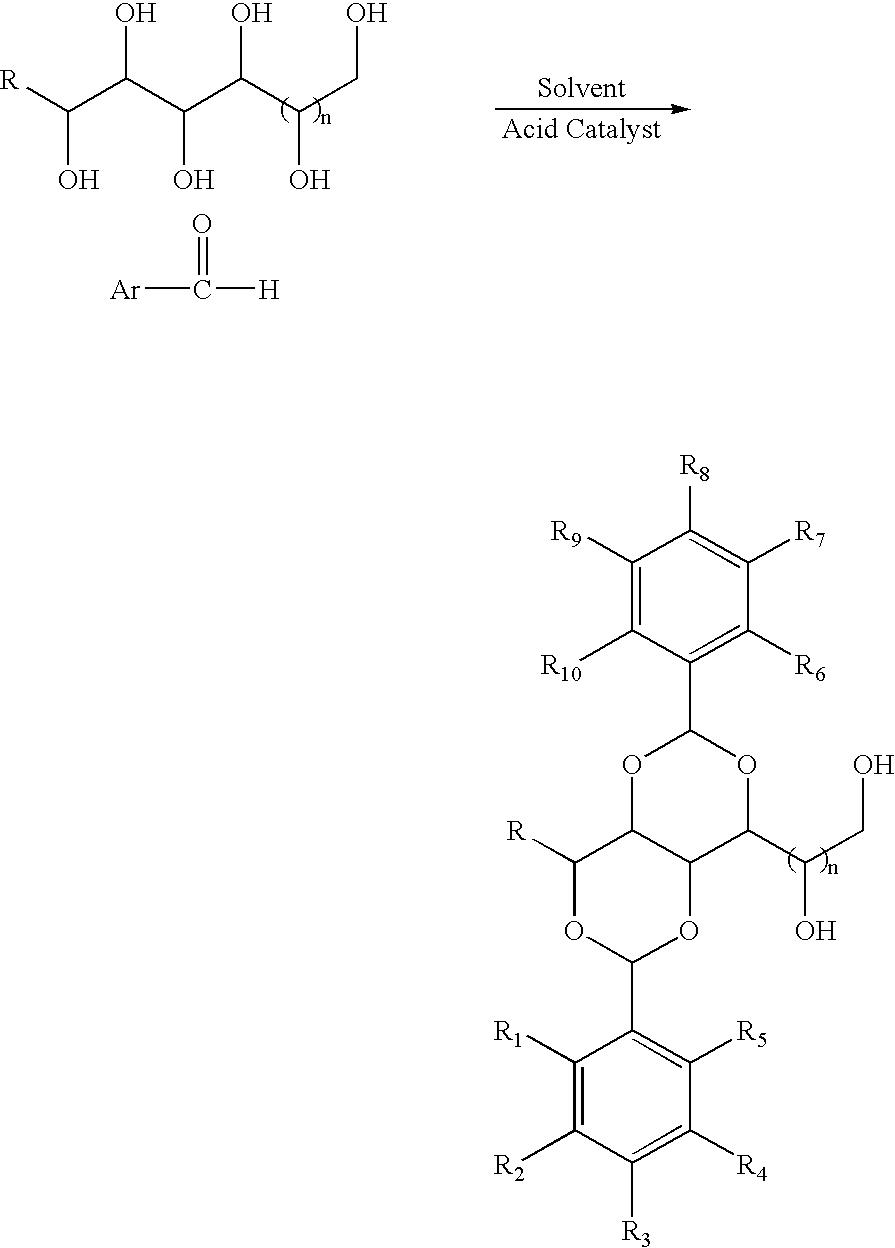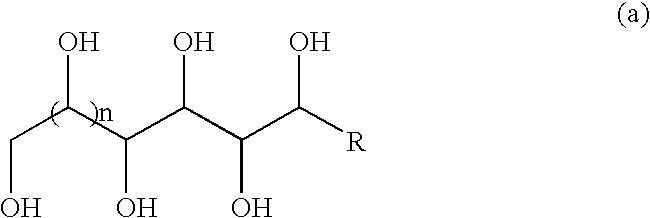Method for preparing acetal-containing compositions
- Summary
- Abstract
- Description
- Claims
- Application Information
AI Technical Summary
Problems solved by technology
Method used
Image
Examples
example 1
1,3:2,4-Bis(3′,4′-dimethylbenzylidene) Sorbitol
[0040] To the white slurry of D-sorbitol (9.11 g, 50 mmol) and 3,4-dimethylbenzaldehyde (13.4 g, 100 mmol) in acetonitrile (100 mL) at room temperature was added a solid of p-toluenesulfonic acid monohydrate (1.9 g, 10 mmol). After magnetically stirring for 12 h, the gel-like material (no visible solvent present) was washed sequentially with boiling water (200 mL×2), cyclohexane (200 mL×2) and boiling water (200 mL×4). After drying in vacuum oven at 110° C. for 12 h, 1,3:2,4-bis(3′,4′-dimethylbenzylidene) sorbitol (20.5 g, 99%) was obtained as a white powder. The product was properly characterized using 1H and 13C NMR, IR and GC / MS.
example 2
1,3:2,4-Bis(3′,4′-dimethylbenzylidene) Sorbitol
[0041] The target molecule was synthesized using similar procedure as described in Example 1 with D-sorbitol (9.11 g, 50 mmol), 3,4-dimethylbenzaldehyde (13.4 g, 100 mmol), and p-toluensulfonic acid monohydrate (1.9 g, 10 mmol) in 1,4-dioxane (100 mL). After the same purification procedure as described in Example 1, 1,3:2,4-bis(3′,4′-dimethylbenzylidene) sorbitol (11.4 g, 55%) was obtained as a white powder. The product was properly characterized using 1H and 13C NMR, IR and GC / MS.
example 3
1,3:2,4-Bis(3′,4′-dimethylbenzylidene) Sorbitol
[0042] The target molecule was synthesized using similar procedure as described in Example 1 with D-sorbitol (9.11 g, 50 mmol), 3,4-dimethylbenzaldehyde (13.4 g, 100 mmol), and p-toluensulfonic acid monohydrate (1.9 g, 10 mmol) in nitromethane (100 mL). After the same purification procedure as described in Example 1, 1,3:2,4-bis(3′,4′-dimethylbenzylidene) sorbitol (11.4 g, 55%) was obtained as a white powder. The product was properly characterized using 1H and 13C NMR, IR and GC / MS.
PUM
| Property | Measurement | Unit |
|---|---|---|
| Temperature | aaaaa | aaaaa |
| Molar ratio | aaaaa | aaaaa |
| Miscibility | aaaaa | aaaaa |
Abstract
Description
Claims
Application Information
 Login to View More
Login to View More - R&D
- Intellectual Property
- Life Sciences
- Materials
- Tech Scout
- Unparalleled Data Quality
- Higher Quality Content
- 60% Fewer Hallucinations
Browse by: Latest US Patents, China's latest patents, Technical Efficacy Thesaurus, Application Domain, Technology Topic, Popular Technical Reports.
© 2025 PatSnap. All rights reserved.Legal|Privacy policy|Modern Slavery Act Transparency Statement|Sitemap|About US| Contact US: help@patsnap.com



